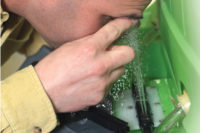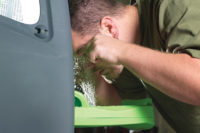Every second counts

More than 2,000 eye injuries occur in the workplace every day and cost companies $300 million per year in lost production time, medical expenses and workers’ compensation, according to the U.S. Bureau of Labor Statistics. With this in mind, having the correct emergency eyewash systems in place is not only a critical component of any company’s safety program, but also a requirement. Though a great deal of focus is placed on primary eyewash systems, it is important to raise the level of awareness and understanding about the existence of supplemental systems and their role in post-incident emergency eye care.
In addition to the preponderance of evidence supporting the need for emergency eyewash systems in the workplace, OSHA requires their use in order to meet eye protection and safety standards. Most companies focus on meeting American National Standards Institute (ANSI) guidelines for primary eyewash units, generally defined as plumbed or portable stations that can deliver an uninterruptable 15-minute flush within a 10-second walk from strong acids or caustics. Yet supplemental eyewash systems, which are small and highly portable, can be as critical for the treatment of an injured eye and, in some cases, are also required to meet OSHA or ANSI guidelines.
Why a secondary unit?
Facility managers may be aware that they are required to have an eyewash station within a 10-second walk from chemicals or other injurious materials, but are they aware that they are also required to have secondary/personal eyewash available when particles such as pollen or other allergens, dust, sawdust or smoke are present? It is of utmost importance to educate facility and safety managers about eye injury risks and meeting compliance standards at their sites.
OSHA sets the overall requirement that employers provide primary and/ or secondary eyewash in eye hazard areas of the workplace. High incident areas most commonly include those involving use of paints and solvents, battery charging, tool parts washing, laboratory work, chemical storage, and chemical pumping and mixing. Injurious materials may be present in solid, liquid, powder, mist or vapor form. While OSHA sets the requirements, it is ANSI that establishes the specific guidelines with which employers must comply in establishing and maintaining work practices relating to eye safety. Specifically, the ANSI Z358.1-2004 Standard for Emergency Shower and Eyewash Equipment is the definitive standard for meeting the OSHA requirement for suitable facilities.
Figuring out your needs
OSHA and ANSI requirements for emergency eyewash can be found in the Emergency and First Aid Section of the Material Safety Data Sheets (MSDS). The MSDS is a detailed bulletin prepared by the manufacturer or importer of chemicals or other hazardous materials that describes the physical and chemical properties, physical and health hazards, routes of exposure, precautions for safe handling and use, emergency and first-aid procedures, and control measures. The information contained on an MSDS helps employers in the selection of safe products and helps prepare employers and employees alike to respond effectively to daily exposure situations and to emergencies.
Every second counts
When an eye injury occurs, every second counts toward a healthful recovery. That’s where secondary/ personal eyewash systems come into play. While not intended to replace primary eyewash equipment, they are an important supplement. Secondary eyewash stations or personal bottles can be located much closer to contaminants and provide immediate treatment before the injured worker is able to reach primary eyewash equipment. They can also be important after primary eyewash equipment is used, while the injured worker is being transported to medical care.
Like primary eyewash stations, the secondary/ personal unit must deliver tepid flushing fluid. The exception is in circumstances where the temperature of the fluid might accelerate the chemical reaction; a safety or health advisor should be consulted for the optimum temperature for each application.
Two types of supplemental systems are available: selfcontained eyewash units and personal eyewash bottles. Both types are suitable for nuisance particles, as well as allergens like dust, pollen, sawdust, smoke or other particles commonly found at many worksites. Nuisance particles and allergens can cause damage to the delicate parts of the eye, causing discomfort if not properly treated.
Self-contained secondary systems
Self-contained secondary eyewash units can be pressurized or gravity-fed — similar to primary units — but provide flushing for a shorter length of time. Typically, these units are smaller in size and less expensive in price. Eye safety and emergency flushing requirements are outlined in the MSDS where contaminants are present.
Personal eyewash bottles
The other type of secondary system is personal eyewash bottles. Bottle volumes vary from a one-ounce first-aid-size bottle to a 32-ounce container. Bottles provide immediate flushing fluid but for a shorter period of time than the 15 minutes required by ANSI for primary eyewash. Bottles commonly contain either saline solution or sterile isotonic buffered saline solution. Personal bottles can be purchased with screw tops or one-time-use, blow-fill-sealed bottles that are tamper resistant, yet can easily be removed in an emergency.
While both self-contained units and personal eyewash bottles meet established standards for supplemental emergency eyewash, sterile solution provides the safest treatment for injured eyes. Sterile solution is 100 percent devoid of anything living — like microorganisms or bacteria — that could further injure an already compromised eye. It is also buffered to match the pH of the human eye, which is especially important in the case of chemical splashes when the eye’s pH is disrupted.
Another benefit of secondary/personal eyewash is that it is inexpensive to use and easy to maintain. As opposed to primary plumbed eyewash stations, for which ANSI requires weekly activation to verify proper operation, personal eyewash units or bottles require only annual inspections for tampering, expiration dates, etc., in order to comply with ANSI Z358.1 Section 8.1.
Plan ahead
As many companies can attest, it is better to take proactive steps to prevent workplace eye injuries than it is to treat them. In fact, 90 percent of eye injuries can be avoided by wearing proper protection. But when an eye injury does occur, make sure your facility and employees are properly equipped to handle that emergency within the very first seconds by having primary and supplemental eyewash systems near all workplace hazards. Educate employees on when to take action, as well as where systems are located and how to use them properly. By doing so, your organization can mitigate the risks, costs and damage involved in one of the most common workplace injuries — the eye injury.
Looking for a reprint of this article?
From high-res PDFs to custom plaques, order your copy today!




